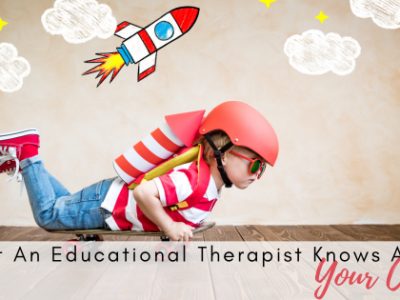
9 Dyslexia Therapy Terms You Should Know
If you’re diving into the world of dyslexia therapy, you’re about to learn a lot. Some terms will be new to you, and they’ll be a gateway to understanding the process and getting your child the help they need.
Multisensory structured language education: This is actually the formal name for dyslexia therapy. Multisensory teaching, as the name connotes, uses senses such as sight, sound, movement, and touch to help readers link language to the words they are learning. Therapists integrate visual, auditory, and motor processing alongside the structure of the English language. This approach establishes a solid foundation for language skills.
Certified Academic Language Therapist (CALT): These individuals have a deep knowledge of the English language structure, and they use these skills to create tailored learning plans for dyslexia remediation. CALT credentials ensure that these professionals are specially trained to work with language-based learning differences.
Basic Language Skills Therapy (BLS): BLS is a dyslexia intervention program. This literary instruction for students with dyslexia is systematic and intensive with a framework that is sequential and comprehensive. BLS provides instruction in phonemic awareness, letter recognition, decoding, spelling, fluency, comprehension, handwriting, vocabulary, and oral-written expression.
Orton-Gillingham: To understand the Orton Gillingham approach to dyslexia is to understand the roots of dyslexia therapy. Dr. Samuel Orton, a neuropsychiatrist and pathologist and Anna Gillingham, an educator and psychologist, developed this system together in the 1930s. Their groundbreaking method combines direct, multi-sensory teaching strategies that work with systematic, sequential lessons with a focus on phonics.
Take Flight: Another comprehensive intervention for students with dyslexia, Take Flight is comprised of a 2-year curriculum that was created by the staff of the Luke Waites Center for Dyslexia and Learning Disorders at the Texas Scottish Rite Hospital for Children (TSRHC). This program is designed to be implemented by a CALT, and it’s recommended for children 7 and older. Take Flight was developed to enable students with dyslexia to achieve and maintain better word recognition, fluency, and comprehension. It also focuses on students transitioning well from a therapy setting to a real-world setting.
Phonemic Awareness: This term refers to a person’s ability to focus on and manipulate individual sounds (phonemes) in spoken words. For example, separating the word “dog” into three distinct phonemes requires phonemic awareness.
Phonemes: Dyslexia terminology breaks things down to the smallest parts. Phonemes are the smallest units that make up spoken language. Phonemes combine to form syllables and words.
Decoding: Decoding (word reading) is essential to learning, and it’s a foundational skill upon which all reading instruction is built. More specifically, it is the process of translating print into speech by matching a letter or a combination of letters to their sounds and recognizing that patterns make syllables and words. Decoding strategies can be taught through dyslexia therapy.
Invisible impacts: There are obvious issues when a student is diagnosed with dyslexia; Reading, spelling, and language grades may suffer. Academic performance measurements can be measured in the classroom. But there are other effects that aren’t quite as visible or tangible that can affect students negatively such as insecurity, anxiety, frustration, isolation, and stress. Dyslexia therapy can help alleviate these invisible impact
There are many more new terms that come into play in the world of dyslexia therapy, click here to learn 11 more dyslexia therapy terms. For more information about how Dyslexia on Demand can help your child, click here to schedule a consultation.







